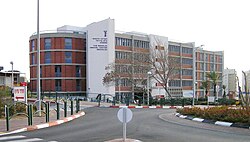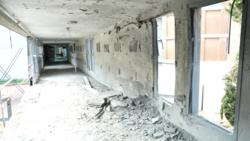Barzilai Medical Center
Barzilai Medical Center
| |
|---|---|
 Barzilai Medical Center | |
 | |
| Geography | |
| Location | Ha-Histadrut, Ashkelon, Israel |
| Coordinates | 31°39′43″N 34°33′35″E / 31.6619°N 34.5597°E |
| Organisation | |
| Care system | Ministry of Health |
| Funding | Public hospital |
| Type | District General, Teaching |
| Services | |
| Emergency department | Yes |
| Beds | 617 |
| History | |
| Former name(s) | Ashkelon Hospital |
| Opened | July 1961 |
| Links | |
| Website | bmc |
| Lists | Hospitals in Israel |
Barzilai Medical Center (Hebrew: מרכז רפואי ברזילי, Merkaz Refu'i Barzilai; Arabic: مركز برزيلاي الطبي) is a 600-bed district general hospital in Ashkelon, Israel opened in 1961.[1] The hospital serves a population of 500,000, including a large number of Ethiopian and Russian immigrants, and has more than 100,000 admissions annually.
The grounds contain the site of the former Shrine of Husayn's Head, a Shia pilgrimage site before its destruction by the Israeli Defense Forces under Moshe Dayan in 1950.
History[edit]

The Barzilai University Medical Center opened on 20 July 1961, and was initially named Ashkelon Hospital. Construction was financed by the Ministry of Health with the assistance of the South African Zionist Federation,[2] the Ashkelon municipality and Mifal HaPayis. The building was designed by the architect David Brutzkus, covering an area of 8,000m².
The first wards to be established were the pediatric and obstetrics departments, with 15 beds set aside for use by the Israel Defense Force. Dr. Michael Lavih, a medical officer in the air-force, was appointed director of the hospital. From 1961 to 1966, the number of beds rose to 150 and the surgery, internal medicine and orthopedic departments opened. A nursing school was inaugurated in 1966.[3]
In 1971, the hospital was renamed for Minister of Health Yisrael Barzilai, who had laid the cornerstone of the building in the early 1960s.[4] and who had died the previous year.
In 2021, Barzilai Medical Center introduced an innovative treatment for chronic skin wounds that combines plastic surgery and orthopedic rehabilitation. The clinic is open to anyone suffering from chronic ulcers or deep wounds in skin tissue.[5]
Effect of Israel-Hamas Conflict[edit]
Situated six miles from Gaza, the hospital has been the target of numerous Qassam and Grad rocket attacks, sometimes as many as 140 in one weekend. The hospital plays a vital role in treating wounded soldiers and terror victims.[6]


Plans to build a new rocket and missile-proof emergency room for the hospital in 2010 were hampered by ultra-orthodox protests sparked by the discovery of human remains in an ancient burial ground unearthed during construction activities.[8] The hospital's new fortified emergency room was dedicated on February 20, 2018.[9]
Since the beginning of the 2023 Israel-Hamas war, Barzilai Medical Center has endured three direct rocket hits. Despite its vulnerable location, the hospital is only partially protected, resulting in a current occupancy rate of just 30%, far below its capacity and need.[10] An underground protected area was built, accommodating 285 beds, but the hospital still struggles with challenges like caring for premature infants and conducting dialysis treatments under these circumstances.[7]
On October 8 2023, the second day of the conflict, hospital administration decided to relocate all patients from the women's and high-risk pregnancy departments to a protected underground area. This decision proved crucial, as shortly afterward, a rocket struck close to the evacuated departments. The hospital director, Prof. Hazi Levi, emphasized the importance of this preemptive action, especially given the severity of damage evident in the aftermath of the rocket strikes.[7]
Landmarks[edit]

A section of the grounds of the hospital is believed to have been the burial place of the head of Husayn ibn Ali (Arabic: رَأس ٱلحُسَين, romanized: Rās al-Ḥusayn), a grandson of Muhammad.[11] In the 11th century, Badr al-Jamali built a shrine known as the Shrine of Husayn's Head (Arabic: مشْهد ٱلنَبِي ٱلحُسَين, romanized: Mäšhäď al-Nabī al-Ḥusyan, lit. 'Mausoleum of our Lord Husayn')[12] at the direction of the Fatimid Imam-Caliph, Ma'ad al-Mustansir. The shrine became a pilgrimage site for Shi'a Muslims and historically also Palestinian Sunnis.[13]: 185–186 [14][15] In July 1950 the multi-story structure was destroyed by Israel Defense Forces under instructions from Moshe Dayan.[13]: 205–206 [16] Around 2000, a marble platform was installed at the site by Mohammed Burhanuddin.[14][11][16][17]
See also[edit]
References[edit]
- ^ ‘We are in a war zone,’ says head of Israeli hospital targeted by rockets, Jerusalem Post
- ^ Margit, Maya (17 December 2019). "Israel's Ashkelon Honors Its Founders (with VIDEO)". The Media Line.
- ^ "About The Barzilai Medical Center". www.bmc.gov.il.
- ^ About The Barzilai Medical Center Archived 28 July 2014 at the Wayback Machine Barzilai Medical Center
- ^ "New treatment for chronic wounds performed at Barzilai Medical Center". The Jerusalem Post | JPost.com.
- ^ "Steady rain of missiles strains Israeli hospital". NjJewishNews.com. New Jersey Jewish News. 8 April 2008. Archived from the original on 22 July 2011.
{{cite news}}: CS1 maint: unfit URL (link) - ^ a b c Efrati, Ido (1 November 2023). "Direct Rocket Hits, Partial Protection: How a Hospital Operates in Israel's Most Bombarded City". Haaretz. Retrieved 10 December 2023.
- ^ "Don't budge Barzilai bones". The Jerusalem Post. 18 March 2010. ISSN 0021-597X. Archived from the original on 3 January 2018.
- ^ [1]
- ^ Efrati, Ido (31 October 2023). "פגיעות ישירות ומיגון חלקי: כך פועל בית חולים בעיר המטווחת בישראל". Haaretz. Retrieved 10 December 2023.
- ^ a b "Sacred surprise behind Israeli hospital". LA Times.
- ^ Michael Press (March 2014). "Hussein's Head and Importance of Cultural Heritage". American School of Oriental Research. Archived from the original on 17 May 2020. Retrieved 17 May 2020.
- ^ a b Talmon-Heller, Daniella; Kedar, Benjamin; Reiter, Yitzhak (January 2016). "Vicissitudes of a Holy Place: Construction, Destruction and Commemoration of Mashhad Ḥusayn in Ascalon" (PDF). Der Islam: 11–13, 28–34. doi:10.1515/islam-2016-0008. Archived from the original on 12 May 2020.
- ^ a b Rami Amichay (9 February 2015). "Prophet's grandson, Hussein, honored on the grounds of an Israeli hospital". Reuters. Archived from the original on 12 May 2020. Retrieved 12 May 2020.
- ^ "أتباع البهرة الشيعية يذرفون الدمع على قبر للحسين في عسقلان" [Shi'a Bohra followers shed tears at Hussein's grave in Ashkelon] (in Arabic). No. 9825. 11 February 2015. p. 20. ISSN 0140-010X. Archived from the original on 31 May 2020. Retrieved 31 May 2020 – via alarab.co.uk.
- ^ a b "History Erased". Haaretz. 5 July 2007.
- ^ "Archeology for Everyone". Municipality of Ashkelon. Archived from the original on 12 May 2020. Retrieved 12 May 2020.
